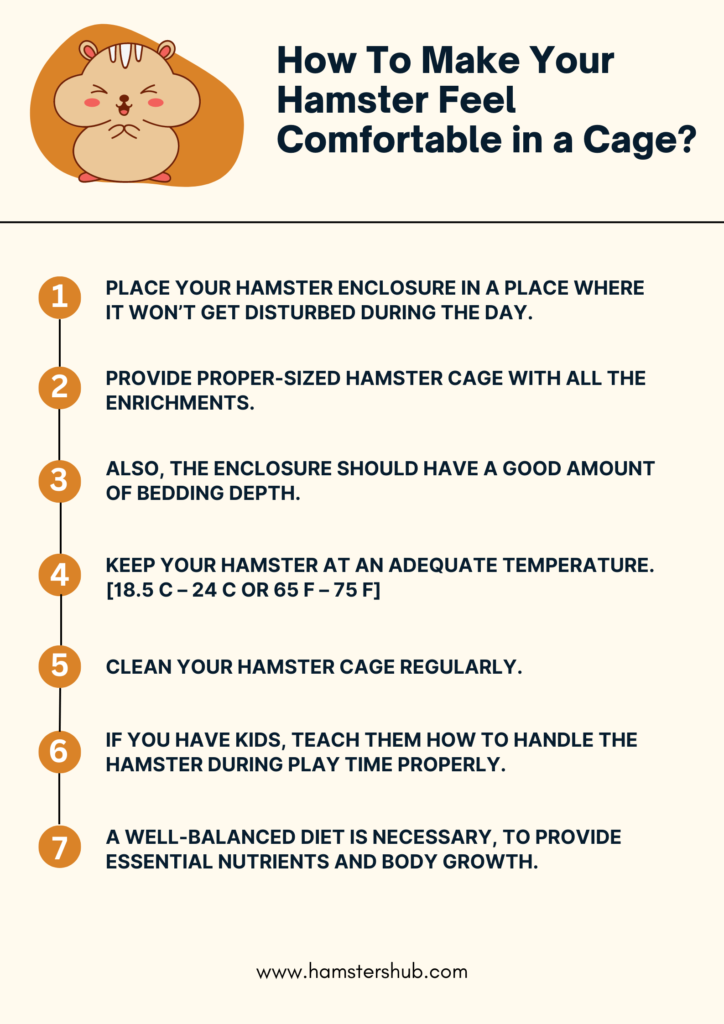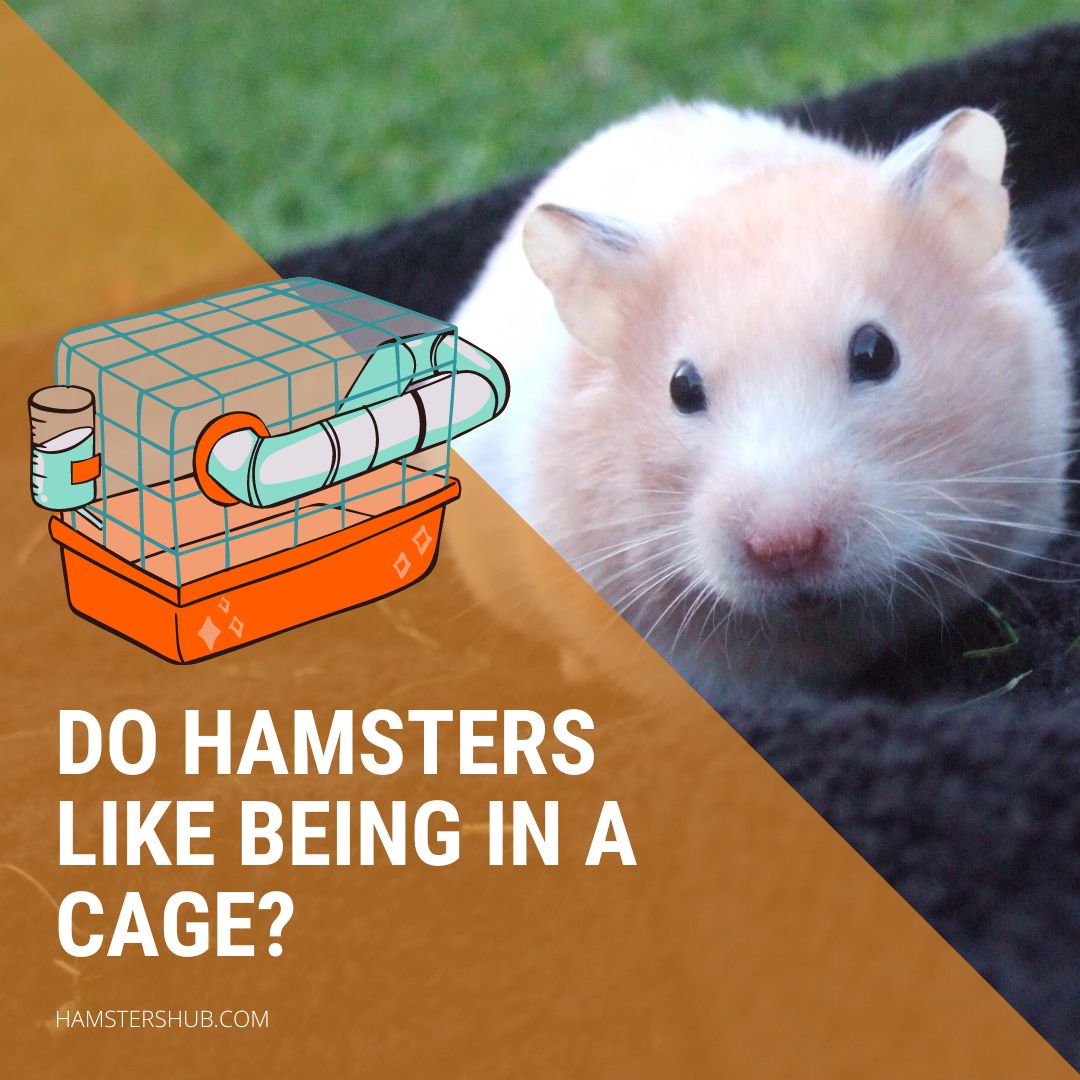When I first got my hamster, I always thought, does my hamster-like being in the cage? What if he yearns for a life where he can roam around all day? With little research on animal behavior and psychology, I got the answer.
Every animal has a place where they go to relax and rest. Nest in the case of birds, trees in the case of leopards, and corals in the case of fishes. These places are a comfort zone for these animals where they feel secure and comfortable.
Similarly, for hamsters, their cage can be their home, a safe place where they know no predator will come, where no one will disturb them, and a safe place where they can keep their food supplies. If proper conditions are provided in an enclosure, your hamster will be happy there and like being in that place.
But if it’s more like a cage, with no proper bedding, toy supplies, or ventilation, then you can easily see in your hamster’s behavior that it doesn’t like being in that cage that you have designed for it.
The main idea of designing an enclosure is to provide the same conditions to the hamsters that they get in the wild. So that they feel comfortable and sound in that place, we can consider an enclosure a cage, but in reality, it’s not a cage; it’s a small area where proper conditions are being artificially created so that hamsters have the same life they require.
The answer is yes; they like being in their enclosure if you have made proper conditions there. But it will really stress them out if no proper arrangements are made for them. It’s up to you if your hamster will like being in the enclosure.
What Do Research / Studies Say about Caged Hamsters?
Various types of research have been conducted over the years regarding hamsters in cages. We will look into four different pieces of research to find out what researchers say about hamster cages.
1. Cambridge university press’s Research on Cage Size
The first research we will look into is published by Cambridge university press. They conducted an experiment on six female golden hamsters, which were kept in four different sizes of cages. The cage sizes were 1800 Cm2, 2500 Cm2, 5000 Cm2, and 10000 Cm2. All the cages were equipped with running wheels, and the litter depth was standardized in all the cages.
In the experiment, researchers found that wire gnawing was observed in all the cages, but hamsters in small cages frequently gnawed the wire for longer. Similarly, in smaller cages, hamsters used the roof of their wooden cages as an additional platform more often than big cage hamsters.
This could suggest that hamsters in smaller cages needed more space. Therefore it was concluded that a cage with a minimal ground area of 10000 Cm2 enhanced the welfare of the hamster compared to smaller cages.[1]https://www.cambridge.org/core/journals/animal-welfare/article/abs/behaviour-of-golden-hamsters-mesocricetus-auratus-kept-in-four-different-cage-sizes/EE15E6061289B1B278F0CD77281F7FF4
2. Running Wheels’ Effect on Hamsters
The second research is on how running a wheel affects the behavior and reproduction of golden hamsters and found that female hamsters with wheels showed less bar-mouthing than females with nonfunctional wheels.
It also found out that hamsters with running wheels had significantly larger litters. This proved that large cages with proper-sized running wheels have a beneficial effect on the well-being of the hamsters.[2]Gebhardt-Henrich, S. G., Vonlanthen, E. M., & Steiger, A. (2005). How does the running wheel affect the behavior and reproduction of golden hamsters kept as pets? Applied Animal Behaviour … Continue reading
3. Influence of the Bedding Depth on Hamsters’ Behaviour
Another research looks into the influence of the bedding depth on the behavior of golden hamsters. Just remember that wire gnawing is used in small rodents to assess housing conditions and welfare. So, 45 male golden hamsters were taken into this research.
Three experimental groups were created, 1st group with deep bedding (80 cm), another group with medium bedding (40 cm), and the last group with low bedding of only 10 cm. It was found that wire gnawing never occurred in hamsters with deep bedding. But the group of hamsters with low bedding showed wire gnawing.[3]Hauzenberger, A. R., Gebhardt-Henrich, S. G., & Steiger, A. (2006). The influence of bedding depth on behavior in golden hamsters (Mesocricetus auratus). Applied Animal Behaviour Science, … Continue reading
Similarly, another research on the effect of cage size and enrichment found that small cages induce chronic stress, which affects hamsters’ thermoregulation. It also showed that improper cages could increase the rate of infection and mortality rate.[4]https://journals.sagepub.com/doi/pdf/10.1258/002367799780578246
All the above research gives an idea of what proper conditions are needed for the hamsters in a cage. Cages with adequate space, adequate bedding material, and depth, with required enrichments, provide the well-needed conditions for hamsters.
How To Make Your Hamster Feel Comfortable in a Cage?
As humans need certain things in our living area to make us comfortable, hamsters also need certain things to be comfortable in their enclosure. Let’s look at things you can do to make your hamster feel comfortable.

- First, you need to know that hamsters are nocturnal, which means they are most active at night and usually rest during the daytime. So place your hamster enclosure in a place where it won’t get disturbed during the day.
- Provide them with a proper size enclosure where they have the required space for a hideout, wheel, all other toys, tubes, water bottles, and sand baths. This will ensure their overall well-being and happiness. Here is an ultimate guide on how to correctly setup a hamster cage.
- Also, the enclosure should have a good amount of bedding depth. Hamsters like digging and burrowing; it’s their natural behavior. Proper bedding depth means they will have adequate space for burrows where they will keep their food, build a nest, and sleep.
- Keep your hamster at an adequate temperature. Hamsters need temperatures between 18.5 C – 24 C or 65 F – 75 F to live comfortably. Extremely low temperatures will lead them to hibernate, and extremely high temperatures will cause dehydration, heat stroke, and organ failure as they can’t sweat like humans. Hamsters come from desert regions, but our pet hamsters can’t withstand extreme temperatures. So you need to keep this thing in mind.
- Cleaning your hamster cage regularly is also important to make them feel comfortable. Your hamster will leave a lot of uneaten food here and there, you’ll need to clean that, and the toilet area and bedding water bottle will also need to be cleaned. Here’s an article showing how to clean your hamster cage.
- If you have kids, teach them how to handle the hamster during play time properly. Hamsters are small animals; even the slightest force can injure them. So give your kids proper training on hamster handling.
- Food is a basic necessity for any organism. Provide your hamster with a well-balanced diet. A proper diet will help in the overall well-being of your hamster.
Is It Cruel to have a Hamster in a cage?
No, having a hamster in a cage is not cruel as long as its requirements are met. The enclosure will be considered a cage if the hamster’s requirements are not met. But if the enclosure is equipped with all the important stuff that your hamster needs, it’s not a cage; it’s home for your hamster.
A place where hamsters can feel safe, make nests, store their food, and sleep soundly. So make sure to provide your hamster with much-needed space with proper bedding depth. Give them a proper diet and exercise so they stay healthy. Hamsters are social creatures, and proper socialism time will help their well-being too.
Do Hamsters Get Bored in their Cage?
Hamsters are active animals. In the wild, hamsters spend most of their time running, gathering food, and digging burrows. Our domestic hamsters don’t need to travel all night to find food, but they are still biologically programmed to be energetic. They can get bored in their cage if conditions like adequate space and toys are not provided.
Bored hamsters can develop issues like biting, over-grooming and lethargy. To prevent this boredom, it’s important for you as a hamster owner to provide your hamster with everything essential for its well-being.
Hamster enclosure should have enough space and plenty of toys that will keep your hamster mentally stimulated. Also, regular play time where your hamster will be out of its cage is beneficial for them. It provides them with much-needed mental and physical stimulation. All these things will make your hamster’s life interesting, and it won’t get bored.
Treats are also great as a boredom breaker, so make sure you give your hamster nice treats frequently.
Do Hamsters Need Time Out of Their Cage?
Yes, hamsters do need a time out of their cage. While a cage can provide a perfect and safe place for your hamster, it also needs time out of its cage so that it can roam around.
Your hamster will get the required exercise it needs during that time. This will not only keep your hamster physically healthy but also mentally healthy too.
You can create a schedule during which your hamster will have time out of its cage. Make sure to have playtime in the late evening or at night. Hamsters are nocturnal, and they are most active at night time.
Also, the place you’ll have playtime should be secure with your other pet animals. Hamsters are small animals and can get easily lost or injured; that’s why it’s advisable always to keep an eye on your hamster during playtime.
References
| ↑1 | https://www.cambridge.org/core/journals/animal-welfare/article/abs/behaviour-of-golden-hamsters-mesocricetus-auratus-kept-in-four-different-cage-sizes/EE15E6061289B1B278F0CD77281F7FF4 |
|---|---|
| ↑2 | Gebhardt-Henrich, S. G., Vonlanthen, E. M., & Steiger, A. (2005). How does the running wheel affect the behavior and reproduction of golden hamsters kept as pets? Applied Animal Behaviour Science, 95(3-4), 199-203. https://doi.org/10.1016/j.applanim.2005.02.019 (https://www.sciencedirect.com/science/article/abs/pii/S0168159105001140) |
| ↑3 | Hauzenberger, A. R., Gebhardt-Henrich, S. G., & Steiger, A. (2006). The influence of bedding depth on behavior in golden hamsters (Mesocricetus auratus). Applied Animal Behaviour Science, 100(3-4), 280-294. https://doi.org/10.1016/j.applanim.2005.11.012 (https://www.sciencedirect.com/science/article/abs/pii/S016815910500393X) |
| ↑4 | https://journals.sagepub.com/doi/pdf/10.1258/002367799780578246 |

